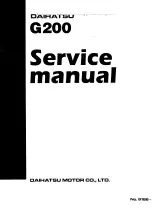
F R E Q U E N T L Y A S K E D Q U E S T I O N S
W H Y I S P R O P E R T I R E I N F L A T I O N I M P O R T A N T ?
Maintaining the recommended tire pressure is essential for the safe and
efficient operation of your Toyota. Safety experts estimate that 25% of
automobiles are running on tires with lower than recommended pressure.
Properly inflated tires run cooler, last longer and improve fuel economy.
W H Y D O E S T I R E P R E S S U R E C H A N G E ?
Many factors affect tire pressure. That’s why it is essential to check your tires
regularly. Tire pressure can decrease due to tire damage, slow leaks or changes
in the outside temperature. For every drop of 5.6ºC in temperature, your tires
lose 1 psi (pounds per square inch). Tires can also deflate naturally over time,
losing as much as 1.5 psi per month.
W H A T D O I N E E D T O K N O W W H E N I S E R V I C E O R R E P L A C E M Y T I R E S ?
• Because tire repair or replacement may affect the tire pressure sensors,
make sure you have your tires serviced by your Toyota Dealer.
• Make sure that only Toyota Genuine wheels are used on your vehicle. Tire
pressure sensors may not work properly with wheels not supplied by Toyota.
H O W D O I F I N D T H E P R O P E R P S I F O R M Y T I R E S ?
The correct tire pressure (in psi) can usually be found on a label located in one
of three places: the driver’s door frame, sill or edge.
D R I V I N G W I T H W I N T E R T I R E S
Take the following precautions to reduce the risk of accidents. Failure to do so
may result in a loss of vehicle control and cause an accident.
• Only use tires of the size specified for your vehicle.
• Maintain the recommended level of tire air pressure.
• Do not drive in excess of 120 km/h, regardless of the type of winter tires
being used.
• Use winter tires on all four wheels.
W H E E L S E L E C T I O N
When you replace your vehicle’s wheels, make sure that they are equivalent to
those removed in load capacity, diameter, rim width and offset. Replacement
wheels are available at your Toyota Dealer.
C H E C K I N G A N D M A I N T A I N I N G Y O U R T I R E P R E S S U R E
O N L Y C H E C K T H E T I R E S W H E N T H E Y A R E C O L D
If your vehicle has been parked for at least 3 hours and has not been driven for
more than 1.5 kilometres, you will get an accurate cold tire inflation pressure
reading.
A L W A Y S U S E A T I R E P R E S S U R E G A U G E
The appearance of the tire can be misleading. In addition, tire pressures that
are even just a few pounds off can degrade ride and handling.
D O N O T B L E E D O R R E D U C E T I R E I N F L A T I O N P R E S S U R E A F T E R D R I V I N G
It is normal for the tire inflation pressure to be higher after driving.
N E V E R E X C E E D T H E V E H I C L E C A P A C I T Y W E I G H T
Passenger and luggage weight should be distributed as evenly as possible so
the vehicle is well balanced.
W H E N I N S P E C T I N G / A D J U S T I N G T I R E P R E S S U R E , R E I N S T A L L T H E
T I R E V A L V E C A P S
Without the valve caps, dirt or moisture can get into the valve and cause air
leakage. This can lead to tire failure and compromise your safety. If the caps
have been lost, replace them as soon as possible.
O
W
N
E
R
I
N
F
O
R
M
A
T
IO
N
2 2
Owner Information
O
W
N
E
R
I
N
F
O
R
M
A
T
IO
N
















































